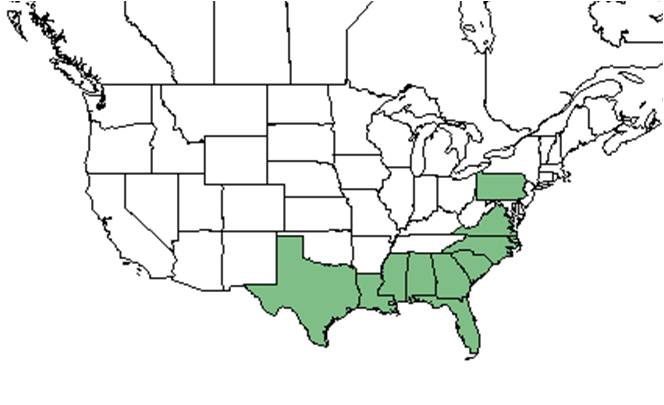Vigna luteola
| Vigna luteola | |
|---|---|

| |
| Scientific classification | |
| Kingdom: | Plantae |
| Division: | Magnoliophyta - Flowering plants |
| Class: | Magnoliopsida – Dicotyledons |
| Order: | Fabales |
| Family: | Fabaceae ⁄ Leguminosae |
| Genus: | Vigna |
| Species: | V. luteola |
| Binomial name | |
| Vigna luteola (Jacq.) Benth. | |

| |
| Natural range of Vigna luteola from USDA NRCS Plants Database. | |
Common name: hairypod cowpea
Contents
Taxonomic notes
Description
Vigna luteola has been observed twining on grasses and shrubs (FSU Herbarium). It has been observed to have yellow flowers and terete fruit (FSU Herbarium).
"Annual or perennial, trailing or climbing herbaceous vines (or occasionally erect). Leaves pinnately 3-foliolate; leaflets entire, stipellate. Racemes axillary usually long-pedunculate, with few to several closely clustered, papilionaceous flowers subtended by small, caduceus bracts and with paired, caduceus bractlets at or near the tops of the pedicels. Calyx campanulate, somewhat 2-lipped, the upper lobes partly or completely united, longer than the lateral but shorter than the lowermost lobe; petals yellow or purple, the keel petals curved but not spirally coiled, about as long as the wings and shorter than the auriculate standard; stamens diadelphous, 9 and 1; ovary sessile, style bearded along the upper surface. Legume linear, terete or slightly compressed." - Radford et al 1964
"Perennial with glabrous to retrorsely pubescent stems, 1-3 m long. Leaflets ovate or more commonly lanceolate to linear-lanceolate, 2-8 cm long, both surfaces more or less sparsely appressed-pubescent; stipules ovate-lanceolate to lanceolate, not extending below the point of attachment. Racemes on elongate peduncles usually several times longer than the subtending leaves and terminated by few to several, closely clustered flowers on retrorsely pubescent pedicels 1-3 mm long subtended by pubescent bracts 1-1.5 mm long and with pairs of 1-nerved, pubescent bractlets 1-1.5 mm long. Calyx the upper lobes united, 2 mm long, the lateral lobes ca. 1.5 mm long and the lowermost ca. 2.5 mm long; petals yellow, 1.4-1.8 cm long. Legume linear, 4-6.5 cm long, appressed-pubescent." - Radford et al 1964
Distribution
Ecology
Habitat
Vigna luteola can occur along bays, river banks, palmetto hammocks, bordering mangrove swamps, lagoon shores, salt marsh banks, scrub oak-palmetto near the coast, along seepage slopes, and coastal sea oats grasslands. It has also been found in disturbed areas such as cleared borders of slash pine flatwoods and disturbed beaches (FSU Herbarium). Substrate types include loamy sand, sandy loam, and oyster shells (FSU Herbarium). Associated species include Bidens laevis, Eupatorium perfoliatum, Aster puniceus, Rynchospora, Uniola paniculata, Helianthus debilis, and Paspalum (FSU Herbarium).
Phenology
Flowers and fruits February through November (FSU Herbarium).
Seed dispersal
Seed bank and germination
Fire ecology
It has been observed growing in recently burned pine woodlands (FSU Herbarium).
Pollination
The following Hymenoptera families and species were observed visiting flowers of Vigna luteola at Archbold Biological Station (Deyrup 2015):
Halictidae: Halictus poeyi
Megachilidae: Anthidium maculifrons, Coelioxys sayi, Dianthidium floridiense, Megachile brevis pseudobrevis, M. exilis parexilis, M. mendica
Use by animals
Diseases and parasites
Conservation and Management
Cultivation and restoration
Photo Gallery
References and notes
Deyrup, M.A. and N.D. 2015. Database of observations of Hymenoptera visitations to flowers of plants on Archbold Biological Station, Florida, USA.
Florida State University Robert K. Godfrey Herbarium database. URL: http://herbarium.bio.fsu.edu. Last accessed: November 2015. Collectors: Loran C. Anderson, K.E. Blum, Sidney T. Brinson, Jane Brockmann, D. Burch, A.F. Clewell, C. Craighead, M. Darst, Delzie Demaree, Robert K. Godfrey, James W. Hardin, W.F. Humphrey, Norlan C. Henderson, Ann F. Johnson, Robert Kral, R.L. Lazor, Robert J. Lemaire, H. Loftin, Sidney McDaniel, Mary E. Nolan, Jackie Patman, Elmer C. Prichard, Paul Redfearn, William Reese, Alberto S. Taylor, S.D. Todd, Alfred Traverse, Edwin L. Tyson, D.B. Ward, Sarah V. Yinger. States and Counties: Alabama: Baldwin. Florida: Bay, Brevard, Clay, Dade, Flagler, Franklin, Hillsborough, Indian River, Lee, Manatee, Monroe, Palm Beach, Pinellas, Putnam, Sarasota, Volusia. Countries: Panama. Compiled by Tall Timbers Research Station and Land Conservancy.
Radford, Albert E., Harry E. Ahles, and C. Ritchie Bell. Manual of the Vascular Flora of the Carolinas. 1964, 1968. The University of North Carolina Press. 639. Print.